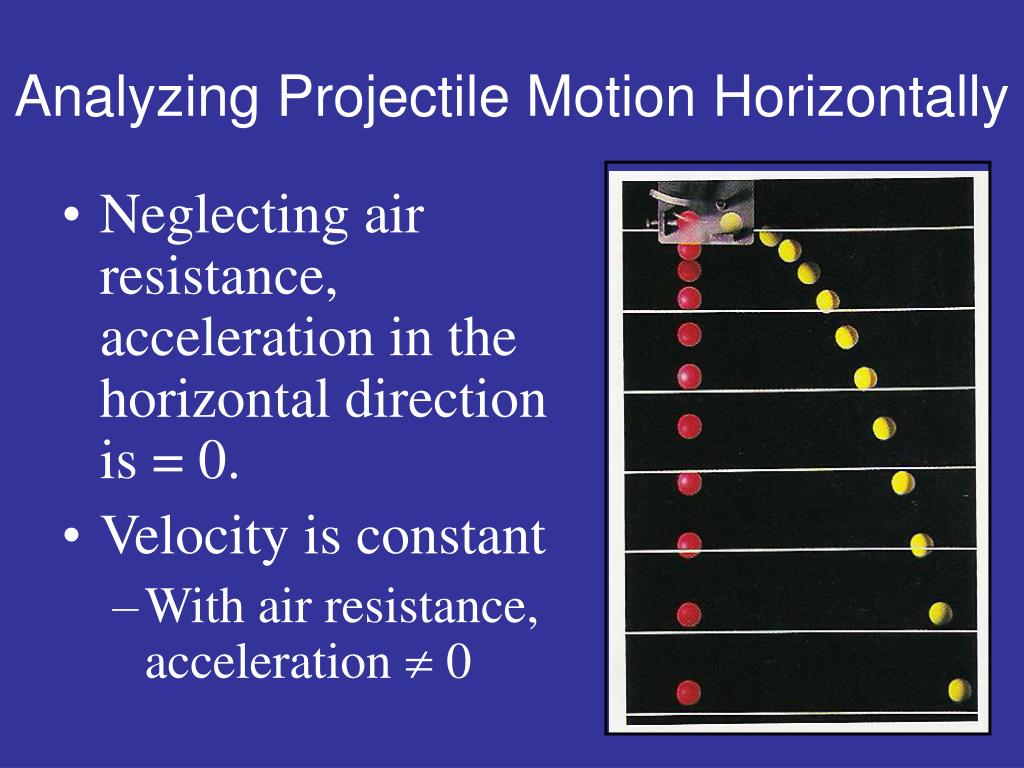

Calculate and plot the trajectory of the baseball with and without air drag. Suppose the baseball is initially at the origin. 3 where B = your student number with 1 significant figure. Suppose the baseball is given an initial velocity of 50 m/s at an angle of o, above the +X- axis where Your studenti en = B B+ -80° n-1 n = 1, 2, 3, 4, 5, 6. וח ות TASK 1 Consider a baseball with a radius r = 3.7 cm, mass m = 0.145 kg, and drag coefficient C = 0.5 and the density of air to be p = 1.2 kg/m. 2 Newton's law gives: F.=-Dvv.=ma, F,- Dwv, - mg=ma, and therefore the components of acceleration including the effects of both gravity and air becomeĭ D a=- P.
#Projectile motion fx free#
Consider the free body diagram shown in Figure 2. 1 The direction of f is opposite the direction of v, so we can write f=-Dūv and the components of f are given by fx=-Dvv, fy=-Dv v. We shall assume that the air is still, and so v is the velocity of the projectile relative to the ground as well as to the air (Fig. The drag coefficient has a value of about 0.5 for spherical objects but can have a value as great as 2 for irregularly shaped objects. The magnitude f of the air drag force is approximately proportional to the square of the projectile's speed relative to the air, namely, f=Dv? wherevº=v+v and D is a constant given by D-AC 2 where p the density of air, A is the cross-sectional area of the moving object measured in a plane perpendicular to its velocity and C is a dimensionless constant called the drag coefficient that depends on the shap of the body. We must now include the air drag force acting on the projectile. For projectile motion with no air resistance, the components of the projectile's acceleration were simply a=0 0,=-9 The +x-axis is horizontal, and the +y-axis is vertically upward. In this lab we study a projectile moving in a plane subjected to air drag. But in fact air resistance (often called air drag, or simply drag) has a major effect on the motion of many objects, including tennis balls, bicycle riders, and airplanes. Theory: In our study of projectile motion, we assumed that air resistance effects were negligible.
#Projectile motion fx how to#
Experiment 1: Computational Physics lab: Motion with air resistance Purpose: In this computational physics lab students will gain an understanding on how to study quantitatively the effects of air drag on the trajectory of a baseball and golf ball. One of the key components of the projectile motion, and the trajectory it follows, is the initial launch angle. Projectile motion occurs when a force is applied at the beginning of the trajectory for the launch (after this the projectile is subject only to the gravity).

The path followed by the object is called its trajectory. Projectile motion is a form of motion where an object moves in a parabolic path. In this atom we will discuss the basic equations that go along with them in the special case in which the projectile initial positions are null (i.e. In a previous atom we discussed what the various components of an object in projectile motion are. Projectile motion only occurs when there is one force applied at the beginning on the trajectory, after which the only interference is from gravity. The path that the object follows is called its trajectory. Projectile motion is a form of motion where an object moves in a bilaterally symmetrical, parabolic path.


trajectory: The path of a body as it travels through space.The horizontal displacement of the projectile is called the range of the projectile, and depends on the initial velocity of the object.When the projectile reaches a vertical velocity of zero, this is the maximum height of the projectile and then gravity will take over and accelerate the object downward.This depends on the initial velocity of the projectile and the angle of projection. The time it takes from an object to be projected and land is called the time of flight.Objects that are projected from, and land on the same horizontal surface will have a vertically symmetrical path.


 0 kommentar(er)
0 kommentar(er)
